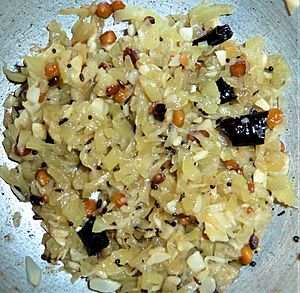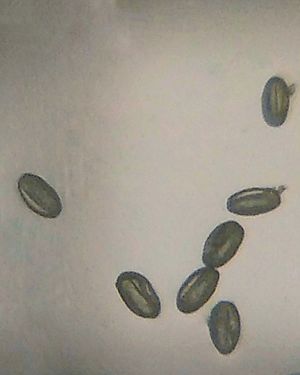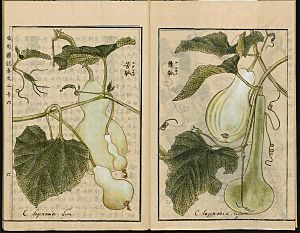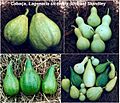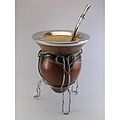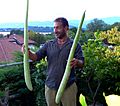Calabash facts for kids
Quick facts for kids Calabash |
|
|---|---|
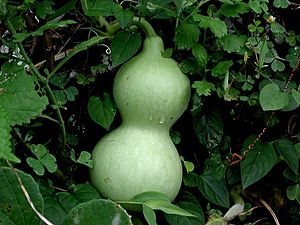 |
|
| Green calabash growing on its vine | |
| Scientific classification | |
| Genus: |
Lagenaria
|
| Species: |
siceraria
|
The Calabash (Lagenaria siceraria), also known as bottle gourd, white-flowered gourd, or long melon, is a type of vine grown for its fruit. You can pick it when it's young and eat it like a vegetable. Or, you can let it grow big and dry, then use it as a container, a tool, or even a musical instrument! When fresh, the fruit has smooth, light green skin and white flesh inside.
Calabash fruits come in many shapes. They can be huge and round, small and shaped like a bottle, or long and winding like a snake. Some can even grow over a meter long! The rounder ones are often called calabash gourds. This plant was one of the first ever grown by humans, not just for food, but mostly for making useful containers. The bottle gourd might have traveled from Asia to Africa, Europe, and the Americas with people moving around, or even by its seeds floating across the oceans. We know it was grown all over the world, including in the Americas, long before Christopher Columbus arrived.
Sometimes, bottle gourds are confused with fruits from the calabash tree (Crescentia cujete). Even though they have similar names and are both used to make containers and instruments, they are not related plants.
Contents
History
The bottle gourd has a very long history! Scientists have found its remains in China and Japan from about 8,000 to 9,000 years ago. In Africa, the earliest record is from about 4,000 years ago in an ancient tomb in Egypt. This suggests that the bottle gourd was first grown by people in Asia, and then much later, in Africa.
Today, the bottle gourd is a popular plant grown in warm, tropical, and subtropical parts of the world. It was first grown by people in southern Africa. Wild bottle gourd plants found in Zimbabwe in 2004 have thinner walls when dried. This means they wouldn't be as strong for carrying water on long trips. The tough, waterproof gourds we see today likely developed over a long time as people chose to grow the strongest ones.
People grew gourds in Africa, Asia, Europe, and the Americas for thousands of years before Columbus sailed to the Americas. For example, in Europe, a monk named Walahfrid Strabo wrote about the gourd as one of the 23 plants in his ideal garden around 800 AD.
For a long time, it was a mystery how this plant, which came from Africa or Asia, ended up in the Americas over 8,000 years ago. One idea was that its seeds floated across the Atlantic Ocean from Africa to South America. However, in 2005, some researchers thought that maybe early hunter-gatherers, called Paleo-Indians, brought the gourds with them from Asia to the Americas at the end of the ice age. They thought this because the ancient gourds in the Americas seemed more like Asian types.
But in 2014, a new study looked at the genes of many bottle gourds. They found that the gourds in North and South America were actually most similar to wild African types. This suggests that the seeds probably did float across the ocean, possibly many times, as far back as 10,000 years ago!
Cultivation
You can grow bottle gourds by planting seeds directly or by moving young plants (about 15-20 days old). The plant likes soil that drains well, is moist, and has lots of good stuff in it. It needs plenty of water when it's growing and a warm, sunny spot that's protected from the wind. You can even grow it in a pot and let it climb on a trellis or roof! In many rural areas, you'll see houses with thatched roofs covered in gourd vines.
Bottle gourds grow super fast! Their stems can reach up to 9 meters (about 30 feet) long in the summer. So, they need strong support if you want them to climb. If you plant them under a tall tree, the vine might even grow all the way to the top! To get more fruit, farmers sometimes cut off the tip of the vine when it's about 6-8 feet long. This makes the plant grow more side branches, which will then produce more flowers and fruits.
The plant has white flowers that open at night. The male flowers have long stems, and the female flowers have short ones with a small fruit shape at their base. Sometimes, female flowers fall off without growing into a gourd. This happens if there aren't any night-flying insects (like moths) to pollinate them. You can help by hand-pollinating them yourself! The pollen grains are tiny, about 60 microns in size.
The first gourds are ready to pick within two months after planting. The first flowers usually appear about 45 days after you sow the seeds. If the plant gets enough food, each plant can produce one fruit per day for about 45 days! Farmers can get a lot of gourds, sometimes 35-40 tons per hectare, in a three-month growing period.
-
Pear-shaped bottle gourd in Seoul, Korea
-
Crook-necked "geese" cultivar in Granville Island Public Market, Canada
-
Serpentine snake gourds in Media, Pennsylvania, United States
-
Collection of bowls and spoons made of bottle gourd from Mali, 2007
Toxicity
Like other plants in the cucumber family, gourds contain natural compounds called cucurbitacins. These can be harmful in large amounts. Cucurbitacins are what make some gourds taste bitter, and they can cause stomach problems. In very rare and extreme cases, people have become seriously ill or even died from drinking unusually bitter gourd juice.
These dangerous cases usually happen when someone drinks gourd juice that tastes extremely bitter. The plant is normally safe to eat when cooked. Gourds become excessively bitter and potentially harmful if they are stored improperly (like in extreme temperatures) or if they are over-ripe. If a gourd tastes very bitter, it's best not to eat it.
Culinary uses
|
||||||||||||||||||||||||||||||||||||||||||||||||||||||||||||
Central America
In Central America, the seeds of the bottle gourd are toasted and ground with other ingredients like rice, cinnamon, and allspice. This mixture is used to make a type of drink called horchata.
East Asia
China
The calabash is often used in southern Chinese cooking. It's popular in stir-fry dishes or soups.
Japan
In Japan, calabash is commonly sold as dried, marinated strips called kanpyō. These strips are used as an ingredient when making makizushi (rolled sushi).
Korea
In Korea, the soft inner part of the gourd has traditionally been eaten as a vegetable side dish called namul. The outer shell is often cut in half to make bowls. Both fresh and dried calabash are used in Korean cuisine. Fresh calabash flesh, prepared by scraping, seeding, and squeezing out moisture, is called baksok. Sun-dried calabash flesh, called bak-goji, is usually soaked before being stir-fried. Soaked bak-goji is often cooked in sauce or stir-fried and added to dishes like japchae and gimbap. Sometimes, fresh baksok is seasoned and eaten raw as saengchae.
-
Bak-namul (seasoned calabash side dish)
Southeast Asia
Burma
In Burma (Myanmar), the calabash is a popular fruit. The young leaves are also boiled and eaten with a spicy, fermented fish sauce. It can also be cut, coated in batter, and deep-fried to make fritters. These fritters are often eaten with Burmese mohinga, a noodle soup.
Philippines
In the Philippines, calabash is often cooked with pork and clear noodles called sotanghon. This dish is usually served over rice.
Vietnam
In Vietnam, calabash is a very popular vegetable. It's commonly cooked in soup with shrimp, meatballs, clams, different kinds of fish (like freshwater catfish or snakehead fish), or crab. It's also often stir-fried with meat or seafood, or added to a hotpot. People also use it as a traditional medicine. Americans sometimes call calabashes from Vietnam "opo squash."
The young shoots, tendrils, and leaves of the plant can also be eaten as greens.
South Asia
India
A popular dish in northern India is lauki channa, which is a semi-dry curry made with channa dal (split chickpeas) and diced gourd. In the state of Maharashtra, a similar dish called dudhi channa is popular. The skin of the vegetable is sometimes used to make a dry, spicy chutney. In Assam, it's eaten with fish curries, as a boiled vegetable curry, and also fried with potato and tomatoes. Lauki kheer (a dessert made from grated bottle gourd, sugar, and milk) is a sweet dish from Telangana, often made for special occasions. In Andhra Pradesh, it's called Anapakaya and used to make dishes like Anapakaya pulusu (with tamarind juice), Anapakaya Palakura (curry with milk and spices), and Anapakaya Pappu (with lentils). Lau chingri, a dish with bottle gourd and prawn, is popular in West Bengal. While often called "Lauki" in northern India, it's also known as kaddu in some eastern parts, though kaddu usually means pumpkin in the north. It's eaten as a dish with rice or roti because people believe it has health benefits.
Bangladesh
In Bangladesh, the fruit is a common dish served with rice.
Nepal
In the Madheshi southern plains of Nepal, besides being cooked as a regular vegetable, calabash is also used to make sweet dishes like halwa and savory dishes like khichdi.
Pakistan
In Pakistan, the calabash is grown widely because its fruit is a popular vegetable.
Sri Lanka
In Sri Lanka, calabash is combined with rice to make a type of milk rice, which is a popular dish.
Cultural uses
Africa
Dried and hollowed-out calabashes are very common tools in homes across West Africa. People use them to clean rice, carry water, and hold food. Smaller ones are used as bowls for drinking palm wine. Calabashes are also used to make many West African musical instruments, such as the Ṣẹ̀kẹ̀rẹ̀ (a rattle like a maraca), the kora (a type of harp-lute), the xalam/ngoni (a lute), and the goje (a traditional fiddle). They also act as sound boxes under the balafon (a West African marimba). In Sierra Leone, calabashes are used to make the shegureh (a women's rattle) and balangi (a type of balafon). Sometimes, large calabashes are simply hollowed out, dried, and used as percussion instruments, especially by the Fulani, Songhai, and Hausa peoples. In South Africa, it's often used as a drinking cup and for carrying food by communities like the Sepedi and IsiZulu. The Erbore children in Ethiopia wear hats made from calabash to protect themselves from the sun. FNB Stadium in South Africa, which hosted the 2010 FIFA World Cup, is known as The Calabash because its shape looks like one. Calabashes are also used to make puppets.
The calabash also has deep cultural meaning. In many African stories, calabashes (often called gourds) are seen as containers of knowledge and wisdom.
-
Calabashes (nkalu in Kikongo) are used to collect and store palm wine in Bandundu Province, Democratic Republic of the Congo
-
The Malian kora player Toumani Diabaté with his instrument
-
Calabash puppet (Marionette)
China
In Mandarin Chinese, the calabash is called húlu (葫芦/葫蘆). It's an ancient symbol for good health. People used to believe hulu had magical healing powers because doctors would carry medicine inside them. It was thought that the hulu could soak up bad energy from the earth that might make people sick, and it's used in traditional Chinese medicine. The bottle gourd is also a symbol of the Eight Immortals, especially Li Tieguai, who is linked to medicine. Li Tieguai's gourd was said to hold medicine that could cure any sickness and never ran out. He would give it to the poor. Some folk stories say that "spirals of smoke would rise from the gourd, showing his power to let his spirit leave his body," and that it "served as a bedroom for the night..."
Dried calabashes were also used as containers for liquids, like drinks or medicines. People also grew calabash gourds in special molds to make them grow into different shapes with pretty flower or swirly designs. Molded gourds were also dried to make homes for pet crickets. The gourd's texture helps the cricket's sound, much like a musical instrument. The musical instrument called hulusi is a type of flute made from the gourd.
-
A Qing dynasty cricket cage
Hawaii
In Hawaii, the word "calabash" often means a large serving bowl, usually made from wood, not necessarily from the gourd itself. These bowls are used for serving food at buffets or in the middle of a dining table. Because of this, terms like "calabash family" or "calabash cousins" are used to describe a large group of friends and family who share meals and are very close.
When ripe, this gourd is often dried and used as a percussion instrument called an ipu heke in traditional and modern hula dancing.
India/Bangladesh
The calabash is used as a sound box (resonator) in many string instruments in India. Instruments that look like guitars are made of wood but can have a calabash resonator at the end where the strings are, called a toomba. The sitar, the surbahar, and the tanpura (or tambura in southern India) can have a toomba. Sometimes, the toomba might not make sound but is kept for balance, like on the Saraswati veena. Other instruments, like the rudra veena and vichitra veena, have two large calabash resonators at both ends of the strings. The Baul singers of Bengal also use musical instruments made from calabash. This practice is also common among Buddhist and Jain wise people.
These toombas are made from dried calabash gourds, using special types of gourds that originally came from Africa and Madagascar. They are mostly grown in Bengal and near Miraj, Maharashtra. These gourds are very valuable and are cared for carefully. For example, they are sometimes given injections to stop worms and insects from making holes in them while they are drying.
-
Sitars and one rudra veena (down right)
-
Rudra veena is a large plucked string instrument used in Hindustani classical music. One of the major types of veena played in Indian classical music, it has two calabash gourd resonators. The vichitra veena, also with two large resonators, is a similar instrument.
-
Ektara (one string) resonator made from a calabash gourd
Hindu holy people (sadhu) traditionally use a dried gourd vessel called the kamandalu. The juice of a bottle gourd is thought to have healing properties and be very healthy (but remember the warning about bitter juice above!).
In some parts of India, a dried, whole gourd is used as a float (called surai-kuduvai in Tamil) to help people learn to swim in rural areas.
Philippines
In the Philippines, dried calabash gourds are one of the materials used to make the traditional hat known as the salakot.
In 2012, Teofilo Garcia from Abra in Luzon, who is an expert at making a special kind of salakot from calabash, received an award from the National Commission for Culture and the Arts. This award, called the "Gawad sa Manlilikha ng Bayan" (National Living Treasures Award), recognized his dedication to the traditional craft of making gourd salakot. This shows that the salakot is an important part of the intangible cultural heritage of the Philippines.
-
Bust of Diego Silang, an 18th-century Filipino revolutionary leader, shown wearing a salakot made from bottle gourd
South America
In Argentina, Uruguay, Paraguay, Chile, and southern Brazil, calabash gourds are dried and carved into mates. A mate (from the Quichua word mathi) is the traditional container for mate, a tea-like drink made from the yerba mate plant. In this region, the drink itself is also called mate, as is the calabash used to make the drinking cups. In Peru, calabash gourds are used in a popular art form called mate burilado. "Burilado" is the special carving technique used to decorate the mate calabashes.
In Peru, Bolivia, and Ecuador, calabash gourds are used for traditional health practices. The ancient Inca culture carved symbols from their stories onto gourds, and this tradition is still important today.
North America
Because calabashes are watertight, they were often used as containers to carry seeds across the Atlantic Ocean during the slave trade. Enslaved people also used them to carry seeds for planting in plantation fields. On plantations where African Americans were enslaved, the calabash became a symbol of freedom. This is hinted at in the song "Follow the Drinking Gourd," which referred to the Big Dipper constellation that guided people on the Underground Railroad to freedom.
Other uses
Tobacco smoking pipe
The dried gourd can be used to make a pipe for smoking tobacco. In the early 1900s, calabash pipes were commonly used in South Africa. People said that calabash gave the smoke a "special softness" that other materials couldn't match. The inside of the pipe was often made of meerschaum, though cheaper ones used tin. A common design of this pipe is famously recognized as the pipe used by Sherlock Holmes in plays and movies. However, the writer who created Sherlock Holmes, Sir Arthur Conan Doyle, never actually said Holmes used a calabash pipe. It became popular for actors playing Holmes because it was easier to balance this pipe while saying their lines.
Traditional health equipment
The gourd is traditionally used in some cultures to help administer certain health treatments. For example, along the upper Congo River, a device for traditional health practices is made by making a hole in one end of the gourd for filling it, and attaching a hollow cane to the gourd's neck using a sticky resin.
Images for kids
-
A tiny growing calabash with flower at night, in West Bengal, India.
See also
 In Spanish: Lagenaria siceraria para niños
In Spanish: Lagenaria siceraria para niños


